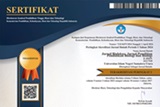Phytoremediation of nickel by Paraserianthes falcataria with varying levels of manure
Abstract
Keywords
Full Text:
PDFReferences
Abbas, A., Azeem, M., Naveed, M., Latif, A., Bashir, S., Ali, A., Bilal, M., & Ali, L. (2019). Synergistic use of biochar and acidified manure for improving growth of maize in chromium contaminated soil. International Journal of Phytoremediation, 22(1), 52-61.
Agus, C., Putra, P.B., Faridah, E., Wulandari, D., & Napitupulu, R.R. (2016). Organic carbon stock and their dynamics in rehabilitation ecosystem areas of post open coal mining at tropical region. Procedia Engineering, 159, 329-337.
Ahsan, M., Younis, A., Jamil, M., Nafees, M., Raza, M.A., & Ahmad, I. (2022). Soil heavy metal pollution: impact on plants and methods of bioremediation. In Hazardous and Trace Materials in Soil and Plants (pp. 73-84). Academic Press.
Bokhari, S.H., Ahmad I., Mahmood-Ul-Hassan M., & Mohammad, A. (2016). Phytoremediation potential of Lemna minor L. for heavy metals. International Journal of Phytoremediation, 18(1), 25-32.
Bosiacki, M., & Zieleziński Ł. (2011). Phytoextraction of nickel by selected species of lawn grasses from substrates contaminated with heavy metals. Acta Scientiarum Polonorum-Hortorum Cultus, 10(3), 155-173.
Chengatt, A.P., Sarath, N.G., Sebastian, D.P., Mohanan, N.S., Sindhu, E.S., George, S., & Puthur, J.T. (2022). Chelate assisted phytoextraction for effective rehabilitation of heavy metal(loid)s contaminated lands. International Journal of Phytoremediation, 1-16.
Cota-Ruiz, K., de Los Santos, Y. L., Hernández-Viezcas, J. A., Delgado-Rios, M., Peralta-Videa, J. R., & Gardea-Torresdey, J. L. (2019). A comparative metagenomic and spectroscopic analysis of soils from an international point of entry between the US and Mexico. Environment International, 123, 558-566.
de Melo, T.R., Figueiredo, A., Machado, W., & Tavares Filho, J. (2019). Changes on soil structural stability after in natura and composted chicken manure application. International Journal of Recycling of Organic Waste in Agriculture, 8(4), 333-338.
de Paula Barbosa, A., Izidoro, M.A., Junior, E.J.M.R., Stephen, J.R.V., de Araújo Rodrigue, P., Fiaz, S., & Benjamin, S.R. (2022). Aromatic Plants as New Candidates in Phytoremediation-OMICS Technology. Principles and Practices of OMICS and Genome Editing for Crop Improvement, 385-414.
Ekperusi, A.O., Sikoki, F.D., & Nwachukwu, E.O. (2019). Application of common duckweed (Lemna minor) in phytoremediation of chemicals in the environment: State and future perspective. Chemosphere, 223, 285-309.
Fleming, M., Tai, Y., Zhuang, P., & McBride, M. B. (2013). Extractability and bioavailability of Pb and As in historically contaminated orchard soil: Effects of compost amendments. Environmental Pollution, 177, 90-97.
Halecki, W., & Klatka, S. (2021). Application of soil productivity index after eight years of soil reclamation with sewage sludge amendments. Environmental Management, 67(5), 822-832.
Haseeb, M., Iqbal, S., Hafeez, M.B., Saddiq, M.S., Zahra, N., Raza, A., & Siddiqui, M.H. (2022). Phytoremediation of nickel by quinoa: Morphological and physiological response. Plos one, 17(1), 26-30.
Haya, A., & Firman, F. (2022). Kajian Kualitas Lingkungan Kawasan Pertambangan di Kabupaten Halmahera Tengah. Jurnal GEOMining, 3(1), 25-32.
Jamal, Q., Durani, P., Khan, K., Munir, S., Hussain, S., Munir, K., & Anees, M. (2013). Heavy metals accumulation and their toxic effects. Journal of Bio-Molecular Sciences (JBMS), 1(1), 27-36.
Juniah, R., & Handayani, H.E. (2018). Post-mining Land of Limestone Quarries for Sengon Plants in PT Semen Baturaja (Persero) Tbk. Indonesian Journal of Environmental Management and Sustainability, 2(4), 138-144.
Khan, A., Khan, S. K. M. A., Khan, M. A., Aamir, M., Ullah, H., Nawab, I. U. Rehman., & Shah, J. (2019). Heavy metals effects on plant growth and dietary intake of trace metals in vegetables cultivated in contaminated soil. International Journal of Environmental Science and Technology, 16(5), 2295-2304.
Khalilzadeh, R., Pirzad, A., Sepehr, E., Anwar, S., & Khan, S. (2022). Physiological and biochemical responses of Phragmites australis to wastewater for different time duration. Acta Physiologiae Plantarum, 44(12), 1-14.
Kim, Y., Chung, Y.S., Lee, E., Tripathi, P., Heo, S., & Kim, K.H. (2020). Root response to drought stress in rice (Oryza sativa L.). International journal of molecular sciences, 21(4), 1513.
Kumpiene, J., Desogus, P., Schulenburg, S., Arenella, M., Renella, G., Brännvall, E., & Sjöblom, R. (2013). Utilisation of chemically stabilized arsenic-contaminated soil in a landfill cover. Environmental Science and Pollution Research, 20(12), 8649-8662.
Laghlimi, M., Baghdad, B., El Hadi, H., & Bouabdli, A. (2015). Phytoremediation mechanisms of heavy metal contaminated soils: A review. Open journal of Ecology, 5(08), 375.
Arroyo, M.D.M.D., Hornedo, R.M.D.I., Peralta, F.A., Almestre, C.R., & Sanchez, J.V.M. (2014). Heavy Metals Concentration in Soil, Plant, Earthworm, and Leachate from Poultry Manure Applied to Agricultural Land. Rev. Int. Contam. Ambie, 30(1), 43-50.
Mishra, J., Singh, R., & Arora, N. K. (2017). Alleviation of heavy metal stress in plants and remediation of soil by rhizosphere microorganisms. Frontiers in microbiology, 8, 1706.
Munir, M.A.M., Liu, G., Yousaf, B., Mian, M.M., Ali, M.U., Ahmed, R., Cheema, A.I., & Naushad, M. (2020). Contrasting effects of biochar and hydrothermally treated coal gangue on leachability, bioavailability, speciation and accumulation of heavy metals by rapeseed in copper mine tailings. Ecotoxicology and environmental safety, 191, 110244.
Pidlisnyuk, V., Mamirova, A., Pranaw, K., Stadnik, V., Kuráň, P., Trögl, J., & Shapoval, P. (2022). Miscanthus× giganteus Phytoremediation of Soil Contaminated with Trace Elements as Influenced by the Presence of Plant Growth-Promoting Bacteria. Agronomy, 12(4), 771.
Pratama, F.N. (2021). Sistem Pemantauan Derajat Keasaman Limbah Air Pada Areal Tambang Berbasis Nirkabel Menggunakan Protokol Lora (Studi Kasus: PT. Wanatiara Persada). Informatics and Digital Expert (INDEX), 3(1), 1-5.
Reddy, S.S., Kumar, P., & Dwivedi, P. (2022). Heavy Metal Transporters, Phytoremediation Potential, and Biofortification. In Plant Metal and Metalloid Transporters (pp. 387-405). Springer, Singapore.
Sheetal, K.R, Singh, S.D, Anand, A., & Prasad, S. (2016). Heavy metal accumulation and effects on growth, biomass and physiological processes in mustard. Indian Journal of Plant Physiology, 21(2), 219-223.
Subhan, E., Salampak, M., Embang, A.E., Masliani, M., Ludang, Y., & Jaya, A. (2020). Eucalyptus and Sengon Plants for Coal Mining Reclamation in Barito East District, Central Kalimantan Province. International Journal of Advanced Research in Engineering and Technology (IJARET), 11(1), 14-22.
Vidaković, A., Liber, Z., Šatović, Z., Idžojtić, M., Volenec, I., Zegnal, I., & Poljak, I. (2021). Phenotypic diversity of almond-leaved pear (Pyrus spinosa Forssk.) along eastern Adriatic coast. Forests, 12(12), 1630.
Wei, B., Yu, J., Cao, Z., Meng, M., Yang, L., & Chen, Q. (2020). The availability and accumulation of heavy metals in greenhouse soils associated with intensive fertilizer application. International Journal of Environmental Research and Public Health, 17(15), 5359.
Xamidova, S.M., Juraev, U.A., & Murodov, O.U. (2022). Effects of phytomeliorant plants on land reclamation condition and salt washing norms. Oriental renaissance: Innovative, educational, natural and social sciences, 2(6), 803-809.
DOI: http://dx.doi.org/10.30821/biolokus.v6i1.2118
Refbacks
- There are currently no refbacks.
Copyright (c) 2023 Jurnal Biolokus: Jurnal Penelitian Pendidikan Biologi dan Biologi
indexed by :












